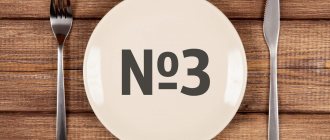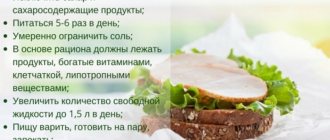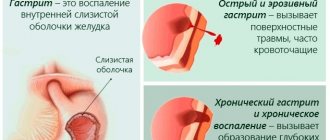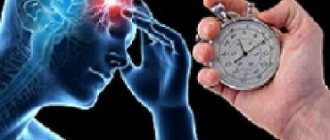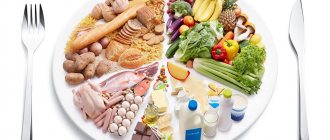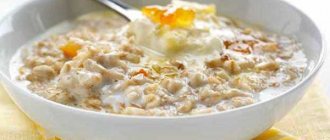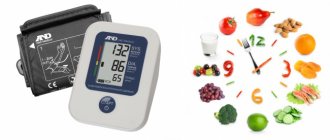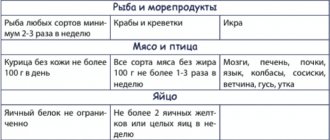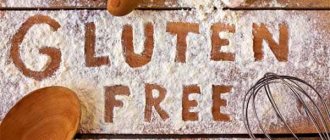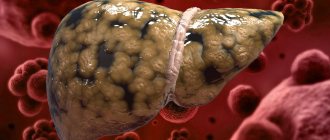Edited by an expert:
Nadezhda Primochkina, nutritionist - 12/04/2019
The main indication for prescribing treatment table No. 8 is usually obesity . The key goal of the diet is to normalize metabolism , without the normal functioning of which it is impossible to eliminate excess fat deposits.
The diet is based on reducing the calorie content of food, a number of restrictions and increasing the amount of dietary fiber in the diet.
Basic recommendations
- Dietary table number 8 according to Pevzner implies a complete abstinence from sugar. Only sweeteners such as xylitol are used.
- Reduces the amount of carbohydrates and fats
- Dishes can be prepared using any culinary method, except frying. Before frying a meat product, it must be boiled
- Number of calories per day – 1700
- Meals per day – 5-6
- Menu for week 8 diet for obesity involves reducing the amount of salt (5-6 grams per day)
- The amount of fluid per day is also reduced - one liter
- Any food temperature
Diet number 8: general characteristics
The goal of this diet is to increase metabolism and “burn” excess fat reserves. The nutritious diet is focused on calorie content of 1600-1800 kcal, but at the same time remains voluminous and satisfying. The energy value decreases due to the reduction of fast carbohydrates and fats.
Nutrition should be multifaceted and replenish the body with a full range of vitamins, dietary fiber and lipotropic substances that oxidize fats. The latter include lactic acid products, eggs, seafood and soy flour.
Food can be steamed, baked, boiled. The consumption of liquids and table salt, baked goods, cream-based desserts is strictly limited, and spicy, fried, and fatty foods are also excluded. The permissible amount of salt per day is 8-10 g, sweet foods - 35-50 g, drinking liquid - 1-1.5 l.
Doctors' advice! Food should be consumed at least 4-6 times a day, chew it thoroughly and not overeat.
Chemical composition of nutrients in diet 8:
- Proteins - 105-120 g;
- Carbohydrates - 110-160 g;
- Fats - 70-80 g;
- Calorie content - 1400-1800 kcal for women and 2100-2700 for men.
Important! The total calorie content of the day is determined depending on the degree of obesity - the higher the weight, the stricter the diet.
Product table
What can you eat while following the Table 8 diet? Diet menu 8 for a week with recipes and instructions can only be compiled based on the table of permitted foods.
Print: possible/not possible
| Product table | Can | It is forbidden |
| Soups | Vegetable soups with a small addition of potatoes or cereals, soups with weak meat or fish broths (beetroot soup, cabbage soup, borscht, okroshka). 300 g per meal | Potato, dairy, cereal, bean soups, as well as soups with pasta |
| Bread and pastries | Rye and “gray” bread no more than 150 g per day | Any sweet pastries and puff pastry products |
| Meat, poultry, fish | Low-fat varieties - beef, rabbit, veal, chicken, turkey. Limited – lean pork and lamb. Lean fish (cod, pollock), seafood | Goose, duck, ham, sausages, frankfurters, smoked meats, canned and fatty meats, fatty fish, salted and smoked fish, canned food in oil, caviar |
| Milk | All low fat dairy products | Full-fat cottage cheese, glazed curds, cream, baked milk, sweet yogurt, fermented baked milk, fatty and salty cheeses |
| Eggs | One or two eggs a day | Fried eggs |
| Cereals | Water-based porridge from pearl barley, buckwheat, and barley, only if the amount of bread is reduced. | Rice, semolina, oatmeal, pasta, legumes |
| Vegetables | Eat most vegetables raw, sauerkraut | Potatoes, green peas, carrots, beets, rutabaga - up to 200 grams per day. Salted and pickled canned vegetables - limit consumption |
| Fruits | Preferably sour varieties | Dates, grapes, bananas, figs, raisins |
| Beverages | Unsweetened vegetable juices, tea, black coffee without sugar and coffee with milk | Cocoa, grape juice, sweet soda |
Soups
The volume of this dish is 300 grams per meal. Vegetable soups with a small addition of potatoes or cereals are allowed, as well as soups with weak meat or fish broths. Diet 8 for obesity for children and adults recommends preparing soups such as beetroot soup, cabbage soup, borscht, and okroshka.
We also recommend reading: Pulmonary embolism, what is it?
Not allowed: potato, dairy, cereal, bean soups, as well as soups with pasta
Bread and pastries
The “Table 8” diet menu involves eating 150 grams of rye and “gray” bread every day.
Important! “Grey” bread is bread made from first and second grade flour.
Not allowed: any rich pastries and puff pastry products.
Meat and poultry
Diet number 8 allows the consumption of 100 grams of meat per day for children and 150 grams for adults. Low-fat varieties are allowed - beef, rabbit, veal, chicken, turkey. Limited – lean pork and lamb.
Important! You can fry meat only after boiling.
Not allowed: goose, duck, ham, sausages, sausages, smoked meats, canned food and fatty meats.
Fish
Low-fat fish (cod, pollock) in the amount of 150-200 grams per day. Seafood allowed.
Not allowed: fatty varieties, salted and smoked fish, canned food in oil, caviar
Dairy
All low-fat dairy products are allowed
Not allowed: fatty cottage cheese, glazed curds, cream, baked milk, sweet yogurt, fermented baked milk, fatty and salty cheeses
About
What can children and adults eat on diet No. 8 for obesity?
Basic principles of diet No. 8: limit free liquid during the day, foods that stimulate appetite, sodium chloride.
Form of preparation of products: baked, stewed, boiled. Dishes are served at normal, regular temperature, and sugar is replaced with xylitol/sorbitol, which is also taken into account in the calorie diary (diet).
You should eat 5-6 times a day.
Foods you can eat on diet No. 8:
- Bread products (from wholemeal flour, rye bread, and also no more than 150 g of protein-bran).
- No more than 150 g/day meat/poultry. Beef jellied meat. Low-fat veal/beef, as well as chicken and turkey and rabbit are prepared boiled or stewed.
- No more than 200 g/day of lean fish or seafood. Frying is not recommended; the ideal option is baking or boiling.
- No more than 2 eggs/day, type – hard-boiled, omelet.
- Light dairy products. As a seasoning - sour cream. Cottage cheese – homemade, no more than 200g/day and no more than 9 percent fat content – only in cheesecakes and puddings. Cheeses – strictly limited and only low-fat.
- All pasta and cereals are strictly regulated and only as components of soups. Only crumbly porridges are allowed, without bread (barley, buckwheat and pearl barley).
- It is recommended to eat most vegetables raw. Cucumbers with zucchini and salad, turnips with pumpkin, beets with tomatoes, all types of cabbage and radishes are allowed. You can also use sauerkraut, but only wash it.
- The limit for a bowl of soup is no more than 250 g per serving. Exclusively vegetable, vegetarian - beetroot soup, cabbage soup, okroshka, etc. On a light broth, let's say meatball soup - 2-3 r/week, or fish soup with vegetables.
- You can eat sweet and sour fruits/berries in different forms - boiled, raw, baked. Mousses and jellies - with sorbitol. Sugar cannot be used for compotes.
- Sauces allowed by the diet are tomato and vegetable, light mushroom.
- Tea/coffee with added milk, tonic green tea, diluted juices.
- Vegetable oil is allowed only in dishes, and butter is strictly limited.
- As for snacks, the diet allows vegetable salads (you can add boiled meat, fish, seafood), vinaigrettes (without mayonnaise), pickled vegetables (limited), light ham and aspic.
Diet No. 8 – what is forbidden to eat:
- All full-fat dairy products, including salty cheeses and sweet cheeses/yogurts.
- All legumes, pasta and cereals, except those allowed.
- Pickles/marinades are prohibited. The “limit” for rutabaga, carrots and green peas and potatoes is no more than 200 g/day.
- Prohibited sweets: ice cream of any kind and jelly, all jams/jams, sugar with honey and all confectionery products.
- You will have to give up raisins with figs, grapes with dates and bananas, as well as other sweet fruits.
- All spices and seasonings, including mayonnaise and fatty sauces, are excluded during the diet.
- As for drinks, restrictions will apply to cocoa, alcohol and sweet juices.
- Under the strictest prohibition are any fats, lard, spicy/fatty snacks, smoked and canned foods, sausages, any fatty meat, caviar, smoked/salted fish.
- Eggs (except for the allowed 2 pieces/day).
- Baked goods, puff buns, products made from wheat flour.
Menu
The menu for a week with the “Table 8” diet can be compiled as follows. For convenience, the menu can be saved to your computer in doc format.
Print menu “Table No. 8”
| Monday | |
| Breakfast | · boiled potatoes · a small piece of “skinny” fish, · fresh cabbage salad, · sugar free coffee |
| Snack | · kefir |
| Dinner | · vegetable soup, · 150 grams of cooked chicken breast, · cucumber, · compote |
| Afternoon snack | · berries, · rosehip decoction |
| Dinner | · egg, · 100 grams of boiled meat, · tea |
| Before bedtime | · Yogurt |
| Tuesday | |
| Breakfast | · egg, · sugar free coffee, · fish cutlets |
| Snack | · a glass of milk |
| Dinner | · vegetable broth soup with pearl barley, · sauerkraut, · beef stroganoff from boiled meat, · compote |
| Afternoon snack | · berries |
| Dinner | · egg, · 50 grams of boiled meat, · tea |
| Before bedtime | · curdled milk |
| Wednesday | |
| Breakfast | · egg · fish aspic, · tea |
| Snack | · apple · kefir |
| Dinner | · vegetable soup, vegetable stew with boiled meat, · compote |
| Afternoon snack | · apple |
| Dinner | · egg |
| Before bedtime | · curdled milk |
| Thursday | |
| Breakfast | egg and kefir |
| Snack | · a small piece of boiled meat, · dried bread, · coffee |
| Dinner | · vegetable soup, · cucumber, · 100 grams of boiled chicken breast |
| Afternoon snack | · apple |
| Dinner | · boiled potatoes, · piece of boiled cod, · fresh cabbage salad, · tea |
| Before bedtime | · kefir |
| Friday | |
| Breakfast | · piece of boiled meat · kefir |
| Snack | · steamed carrot soufflé, · apple, · coffee |
| Dinner | · lean cabbage soup, · boiled potatoes, · piece of boiled cod, · compote |
| Afternoon snack | · baked apple |
| Dinner | · a small piece of boiled chicken breast, · tea |
| Before bedtime | · kefir |
| Saturday | |
| Breakfast | · 100 grams of cooked beef, · kefir |
| Snack | · egg, · apple, · coffee |
| Dinner | · vegetarian borscht, · boiled potatoes, · piece of boiled meat, · compote |
| Afternoon snack | · apple |
| Dinner | · two tablespoons of green peas · a piece of boiled meat |
| Before bedtime | · kefir |
| Sunday | |
| Breakfast | · kefir and egg |
| Snack | · 100 grams of boiled chicken breast, · green pea, · apple, · coffee |
| Dinner | · vegetable soup, · cucumber, · 100 grams of boiled beef, · compote |
| Afternoon snack | · apple |
| Dinner | · piece of boiled cod, · mashed potatoes, · cabbage salad, · tea |
| Before bedtime | · kefir |
Features of diets 8A and 8o
These are more restrictive diets that are prescribed to patients with high degrees of obesity. They are distinguished by a reduced energy content of the diet.
Table 8A involves limiting the energy value of the diet to 1200-1300 Kcal:
- 80 gr. proteins (up to 70% animal origin);
- 60 gr. fats (30-35% vegetable fats);
- 130 gr. carbohydrates.
In case of obesity of the III-IV degree and the ineffectiveness of the diets described above, an 8o table with an energy value of 600-800 Kcal is prescribed:
- 40-50 gr. proteins;
- 30-40 gr. fat;
- 50-70 gr. carbohydrates.
Free fluid is limited to 0.8–1.2 l/day. It is prescribed for a period of no more than a month and only in a hospital, under the supervision of doctors.
When introducing diets 8A and 8o, you cannot start with a low-calorie diet. First, a moderately reduced diet is introduced (table 8), and a gradual transition to low-energy diets is made. With such a smooth transition, the body does not experience serious stress and gradually adapts to a hypocaloric diet. Fasting, a sharp reduction in calories and strict mono-diets aggravate an already impaired metabolism.
Why is it important?
People who begin their journey to an ideal weight by sharply restricting food calories and completely eliminating their favorite foods face food depression - persistent psychological discomfort and dissatisfaction with the diet they have to follow.
In studies by Japanese scientists, it was found that a monotonous and tasteless diet has a negative effect on the psyche of a person losing weight. There is progressive apathy, depression, anxiety, irritability, poor sleep and dissatisfaction with one's life. This condition is due to the fact that when following a diet, the body experiences a lack of useful and necessary elements for the body, and the brain is in a stressful state.
Very often, food depression often disrupts weight loss: in an attempt to regain the lost taste of life, a person begins to mindlessly and uncontrollably consume forbidden foods, overeats, but still does not get the pleasure from food that he had before. This condition is more typical for women.
Eating depression causes great harm, so doctors warn people against strict diets and sharp restrictions on their usual diet. Even if they are prescribed for health reasons, you need to gradually reduce the caloric content of your diet and avoid harmful foods. You should also learn how to correctly use acceptable seasonings and spices (dill, parsley, etc.) - they can give even a dietary dish a pleasant taste and aroma.
Remember! The higher the degree of obesity, the longer the adaptation period lasts, i.e. Caloric and dietary restrictions should be gradual.
If you need to adhere to a low-calorie diet, it is important to control not only your weight, but also your overall well-being and health. If side effects such as weakness, nausea, fatigue, chills, the smell of acetone from the mouth, gastrointestinal dysfunction, dry skin, menstrual irregularities in women, heart rhythm disturbances develop, the diet should be discontinued. In light of the possible development of such complications, serious diets should only be carried out under the supervision of a physician.
Recipes
Diet 8 recipes should contain a minimum of calories, but the dishes should be tasty. Dishes for the week in the Diet 8 menu can be like this:
Vegetable stew
- Four zucchini
- Two bell peppers
- Six tomatoes
- Four potatoes
- Olive oil
Blanch the tomatoes and peel them. We cut the zucchini and potatoes into cubes, and the bell pepper into strips. Heat olive oil in a thick-bottomed frying pan and add vegetables. Fry for 5 minutes, stirring occasionally, then cover with a lid and simmer for 40 minutes.
Steamed carrot soufflé
- Two large carrots
- Two eggs
- Sugar
Grate the carrots on a fine grater. Beat the whites until thick foam. Grind the yolks with sugar. In a separate container, carefully mix all this and place it in a steamer container. Cooking time – 35 minutes.
Vegetarian borscht
- 1 carrot
- 1 potato
- Two handfuls of shredded cabbage
- Two tomatoes
- One beet
Bring one and a half liters of water to a boil and add grated carrots, diced potatoes and cabbage. Separately, boil the grated beets in a small amount of water, strain and add to the soup. Cook until the vegetables are ready, and at the very end of cooking add the tomatoes, previously peeled and cut into cubes.
Diet 8: strictly prohibited foods
The list of foods that are not allowed to be consumed if you are obese includes:
- Flour of the highest and first grade and bakery products based on it, semolina.
- Puff and yeast baked goods.
- Dairy products with fat content more than 10%.
- Rich meat and vegetable broths.
- Sausages, pork sausages, meatloaves, pates, lard, fatty meats.
- Pasta products (except for pasta made from durum varieties).
- Polished rice.
- Legumes.
- Cream, ice cream, cheese desserts.
- Sweet dried fruits (dates, dried apricots, figs, raisins).
- Bananas, grapes, persimmons.
- Sweet juices and sparkling waters.
- Marinades and sauces, incl. mayonnaise and ketchup.
- Confectionery, spread, margarine.
- Honey, jelly, marmalade, marshmallows, Turkish delight.
- Cocoa, chocolate and strong coffee.
- Spices and seasonings.
With strict adherence to Diet 8 for obesity, weight disappears gradually. If the slow movement of the needle on the scale upsets you, you can resort to light physical activity in the gym or just do gymnastics every day. This way, the weight loss process will go much faster.
The use of spices in the diet menu is considered a very controversial issue. Pevzner was sure that they stimulate the already increased appetite and contribute to unnecessary snacking. The opinion of modern nutritionists is that spices in combination with animal proteins, on the contrary, increase metabolism. Therefore, to improve the taste of dishes, it is still allowed to add dill, basil and cockerel as spices.
First day
First breakfast Zucchini stuffed with cod and carrots - 250 g; rye bread—100 g; tea with xylitol - 3/4 cup. Second breakfast Green peas with butter - 200 g; protein bread - 50 g; tomato juice - 100 g. : green cabbage soup beef in sweet and sour sauce with stewed cabbage - 120 and 200 g; rosehip infusion with xylitol - 1/2 cup; rye bread - 150 g. Afternoon snack Cabbage salad with carrots with sour cream - 100 g; rye bread - 50 g. Dinner Low-fat cottage cheese - 100 g; salt-free bread - 50 g; tea with sorbitol - 100 g At night Curdled milk - 1 glass.
A few more recommendations
- To lose body fat faster, try to have dinner and afternoon snacks without carbohydrates.
- If you feel that you are not full with breakfast, replace your morning salad with porridge on water , and eat a small baked potato for lunch.
- The classic diet allowed the use of sweeteners like aspartame, but scientists found that they increased appetite.
- Diet Table No. 8 takes place without cheat meals, also known as “cheat days,” when we allow ourselves to eat something forbidden (like a hamburger).
- Combine your nutrition plan with exercise. Ideally, this 2-3 strength and 1 cardio workouts per week (dancing, running, yoga or swimming). Don’t be afraid to quickly run out of energy: your new diet is full of fiber and protein, which means you won’t suffer from weakness and hunger. Bonuses: even more energy and a boosted metabolism.
And most importantly: be positive and believe in yourself. Do you dream of losing 5, 10, 15 kilograms? This diet is what you need. After it you will feel a surge of strength and a desire to live and create . No fatigue, no painful feeling of hunger and no return of lost kilograms after completing the course.
Previously, we wrote about another dietary complex called table No. 5. It is aimed at cleansing the bile ducts , liver and comprehensive improvement of the gastrointestinal tract. This may be useful to you and your loved ones.
If you found this article helpful, please share it with your friends. And be healthy!
- Share on Facebook
Fourth day
First breakfast Fish meatballs in marinade with boiled cabbage - 75 and 200 g; protein-bran bread - 50 g; tea with xylitol - 3/4 cup. Second breakfast Green beans in milk sauce - 200 g; Protein-bran bread - 50 g. Lunch Borscht with mushrooms - 250 g; beef with prunes - 75 and 100 g; rye bread—150 g; tomato juice - 1 glass. Afternoon snack Chopped egg with sour cream - 70 g; rosehip infusion - 1/2 cup. Dinner Vegetable casserole with boiled beef - 280 g; rye bread - 50 g; tea with xylitol - 1/2 cup. At night Kefir - 1 glass.
Second day
First breakfast Egg white omelette with cauliflower - 100 and 150 g; rye bread - 100 g; tea with xylitol - 1 glass. Second breakfast Fried liver with onions - 75 g; rye bread - 50 g. Lunch Broth from fish waste 250 g; hake with mushrooms in milk sauce—180 g; protein bread - 50 g; rye bread - 100 g; apple-lemon drink—1/2 cup. Afternoon snack Sandwich with meat pate - 50 and 50 g; boiled milk - 3/4 cup. Dinner Boiled fish with stewed cabbage - 100 and 200 g; rye bread - 50 g; tomato juice - 1/2 cup. At night Kefir - 1 glass.
General principles of nutrition
A treatment table that promotes the treatment of obesity is based on the following principles:
- The calorie content of the diet is minimal.
- Carbohydrates - in minimal quantities.
- Fats are rarely and limitedly present in the diet.
- The feeling of fullness comes due to the large number of vegetables on the menu, which fill the stomach, stopping hunger for a long time, while their calorie content is minimal.
- The diet is strictly fractional. Meals are taken up to 6 times a day.
- The portion size is small.
- Lack of refined foods in the diet.
- Regular moderate physical activity.
- Daily presence of coarse fiber in the diet.
- Exclusion of herbs and spices, which, having a strong and spicy smell, stimulate the appetite.
- Limited salt intake, no more than 5 g per day.
- Water limit - no more than 1.5 liters per day.
- Mandatory fasting days.
- Vegetable fats amount to 40 g per day and are used only for cooking.
Weight loss occurs due to:
- By giving up sugar and sweets, which helps level out insulin concentrations, the feeling of hunger and the desire to constantly snack on something disappear.
- Refusal of salt - liquid retention is eliminated.
- Fractional nutrition - due to the small volume of portions, there is a gradual decrease in the volume of the stomach. Over time, a person will no longer be able to physically eat much.
The large amount of fiber in vegetables that form the basis of the diet promotes satiety with a minimum amount of calories. Lack of hunger and decreased appetite contribute to changes in the taste perception of food. A person stops experiencing physical cravings for food.
A proper and balanced diet helps speed up metabolism and activate the process of producing substances that break down fats. Thanks to this process, all foods are well digested, there is no fat deposits, and the body is saturated with the necessary amount of energy.
All products included in the diet of dietary table No. 8 are rich in vitamins, minerals and nutrients. Proper processing of food during cooking allows you to preserve the beneficial properties of products.
The key to success in the treatment of obesity while following diet No. 8 is the correct distribution of calories and the ratio of BJU per day:
- proteins - from 90 to 100 g;
- fats - from 80 to 90 g;
- carbohydrates - from 200 to 250 g.
The total number of calories per day should be from 1900 to 2200 units.
Obesity and indications for diet
Obesity is a disease characterized not only by a person being overweight, but also by the development of diseases of the digestive, endocrine and vascular systems that arise as a result of the accumulation of large amounts of subcutaneous fat. This is not just a cosmetic defect. Obesity can lead to diabetes mellitus, thyroid dysfunction, and cause stagnation of blood in the vessels with the formation of blood clots.
Cure obesity means putting the entire body in order, restoring and adjusting vital processes, improving appearance and prolonging health, preventing the development of severe and life-threatening complications.
According to statistics, every 6 people on the planet have problems with excess weight, bordering on obesity. The cause of excess body weight is eating disorders, abuse of large amounts of junk food, love of fast food and fatty, fried foods, and a passive lifestyle.
Treatment for obesity means “moving in the opposite direction,” i.e., normalizing eating behavior, switching to light foods, and giving up excessive calories. Therapeutic diet No. 8 is a medical prescription for the fight against extra pounds. Diet therapy is recommended in the following cases:
- increased body weight that does not meet the growth rate;
- impaired metabolism;
- slow metabolism;
- all stages of obesity.
Adhering to a therapeutic diet is recommended for those people who have a genetic predisposition to excessive obesity, sedentary work, and lead a passive lifestyle without performing regular physical activity.
Table number 8: what not to do
The meal plan excludes:
- pork, lard, lamb, all sausages, except beef sausages and “doctoral”, but not more than 2 times a week;
- rich pastries, pasta, semolina, milk porridge with butter, polished rice, semi-finished cutlets and soups, dumplings;
- salted fish and caviar, mayonnaise, mustard, sauces with vinegar, salted cheeses, pickled vegetables;
- chocolate, jam, ice cream, store-bought juices and carbonated drinks, very sweet fruits (grapes, bananas, apricots, melon, peaches), sweet yoghurts;
- alcohol.
Nutrition for obesity: important rules and tips
1. A prerequisite is split meals: food is digested better if the body takes it at the same time. In addition, you should not allow yourself to feel hungry.
2. Ban yourself from snacking.
3. You cannot eat in front of the TV or read while eating.
4. Higher calorie meals should be eaten in the first half of the day.
5. If during a meal you feel that you don’t want to eat anymore, you don’t need to finish the portion by force.
6. When buying products, pay attention to their calorie content.
7. Before eating, slowly drink ½ glass of clean water.
Advantages and disadvantages
The advantages of such restrictions include the following:
- allows you to lose weight without harm to your health;
- allow you to restore the functioning of the gastrointestinal tract;
- does not lead to the formation of loose skin.
The disadvantages include the following:
- for a good result, consultation with a specialist is necessary, and in case of grade 4, 24-hour medical supervision;
- It is quite difficult for those who have not previously followed diets and did not arrange fasting days.
The essence and principle of the diet
The basic principles of this diet include the following:
- Mandatory reduction in caloric intake , which primarily concerns fats and carbohydrates;
- Maintain your daily protein intake or slightly increase it. This is necessary in order to preserve muscle tissue, it will also help get rid of the constant feeling of hunger, and digesting protein foods will increase the body’s energy expenditure, which will affect the reduction of adipose tissue;
- Limiting carbohydrate intake. All confectionery products, candies, sweets, pastries, and white bread are almost completely removed from the diet;
- Reducing fat intake per day. They cannot be completely excluded. Vegetables should make up approximately 30%. Healthy fats are important for the body, skin and hair. They maintain a feeling of fullness for a long time, and most importantly, actively help dissolve existing fat reserves;
- Reducing the amount of salt consumed. No more than 8 grams are allowed per day. In this case, we need to take into account not only the salt that we ourselves add to our dishes, but also that which was used in the production of finished products or semi-finished products. At first, this new rule will allow you to cope with hunger and be satisfied with less food. And in the future, low-salt food will relieve fluid retention in the body, which means edema and other health problems;
- Refusal of alcohol in any form. Most alcoholic products themselves are very high in calories. And after even a small dose of drinking, we lose control over food, which leads to excessive consumption and increased appetite;
- Avoiding foods that may increase hunger. These include smoked meats, pickles, fatty broths, spices, sauces, and marinades.
All confectionery products, candies, sweets, pastries, and white bread are almost completely removed from the diet.

